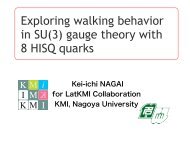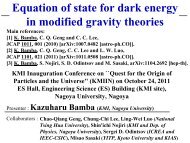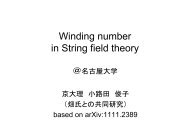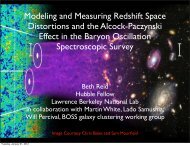sence, function the complete represents sethe of equations unique F(R,T) Lagrangian that describes thatthe satisfies general gravity thelinear usual perturbations continuity equation for the kind (17) of within models the considere class o e, elsf(R, given T )=f by expression 1 (R) +f IV. 2 (12). (T ), PERTURBATIONS have been obtained, which IN f(R, provides T ) THEORIES enough information about the behavior of th turbations within this class of theories, that can be compared with expected results from ΛCDM model. consider the scalar perturbations of a flat FLRW metric in the longitudinal gauge IV. PERTURBATIONS IN f(R, T ) THEORIES V. Cosmological EVOLUTION perturbations OF SUB-HUBBLE MODES AND THE QUASI-STATIC APPROXIMATION ds 2 = a 2 (η) (1 + 2Φ)dη 2 − (1 − 2Ψ)dx 2 , (21) et us consider the scalar perturbations of a flat FLRW metric in the longitudinal gauge ≡e Φ(η, are interested x) and Ψ in ≡ the Ψ(η, possible x) are the effects scalar on perturbations. the ds 2 = a 2 (η) density contrast The components evolution (1 + 2Φ)dη 2 − (1 − 2Ψ)dx 2 once of perturbed the perturbations energy-momentum enter the Hubbl ius thisingauge the matter are given dominated by era. In the sub-Hubble limit, i.e., H k, and , after having neglected all the (21 tim ivative for the re Φ ≡ˆδT Φ(η, 0 x) and Ψ ≡ Ψ(η, x) are the scalar perturbations. The components of perturbed energy-momentum 0 = ˆδρ Bardeen’s potentials Φ and Ψ, the equations (25) and (26) i = ρ 0 δ , ˆδT j = −ˆδp δ i j = −c 2 sρ 0 δ i 0 jδ , ˆδT i = −ˆδT i 0 = − can be combined yielding ⎛ ⎞ 1+c 2 s ρ0 ∂ i v, (22) or in this gauge are given by2k2 f 1+ 1R0 R 0 a 6 denotes the potential Ψ = ˆδT 0 0 = ˆδρ Φ 2 f 1R0 for the velocity perturbations. Using the model (12), the i = ρ 0 δ , ˆδT j = −ˆδp δ i j = −c 2 sρ 0 δ i 0 jδ , ˆδT i = −ˆδT i 0 = − perturbed metric (21) and rbed The energy-momentum perturbed equation 1+ tensor can 1+c 2 s 4k2 f 1R0 ; Φ = − 1 4k2 f 1+ 1R0 R 0 a ⎝ 2 f 1R0 ⎠ R 0 be (22), reduced the first to, 2k order perturbed 2 a ρ0 ∂ i v, (22 when combined yield 2 f 1R0 1+ 3k2 f 1R0 κ 2 a 2 ρ 0 − f 2T0 δ . (35 R 0 f a 2 1R0 equations f 1R0 reads addition, re v denotes the µ equation the potential for velocity perturbations. Using the model (12), the perturbed metric (21) and f perturbed 1R0 ˆδG energy-momentum ν +(R µ 0ν + ∇µ ∇ ν − tensor ν µ ) f (22), 1R0 Rthe 0 ˆδR + µα ˆδg ∇ first order perturbed ν ∇ α δ equations ν ˆδg µ αβ δ 3f(34) 2T0 in the QS approximation + H 1 − ∇ reads α ∇ β f 1R0 2(κ 2 δ + k 2 f 2T0 − f 2T0 ) 2(κ µ f 1R0 ˆδG ν +(R µ 0ν + − g αµ γ ∇µ ∇ ν − δ ν µ ) f 1R0 R 0 ˆδR + µα ˆδg ∇ ν ∇ α − δ ν ˆδg 0 ˆδΓ 2 − f 2T0 ) δ + yields, αν − δ ν µ g αβ γ 0 ˆδΓ k2 Φ − 3Ψ 3f 2T0 − 3H 1 − 2(κ 2 Ψ = 0 (34) − f 2T0 βα ∂ γ f 1R0 = − µ (κ − f αβ 2T0 ) ˆδT ) δ 3f 0 2T + H 1 − ν µ nce, the complete set of equations that2(κ describes 2 − f2T 0 the ) δ + k 2 f2T 0 general2(κ linear 2 − perturbations f2T 0 )δ + k2 Φ = 0 (36 for the ∇ α kind ∇ β of f 1R0 models considered f(R, In T )=f the sub-Hubble 1 (R) +f 2 (T limit, ), have k Hbeen 1 + − g αµ γ 0 ˆδΓ αν − δ ν µ g αβ γ 2 (1 obtained, − which 0 ˆδΓ c2 s)f 2T0 δ ν µ provides +(1− 3c 2 enough s)(1 + c βα ∂ 2 information s)ρ γ f 0 f 2T0 1R0 = T − (κ − f 2T0 ) ˆδT ν µ 0 u µ about the behavior of the en, by using the previous result (35) in the equation (36) one gets rbations within this class of theories, that can be compared with expected results u from ν ˆδρ ΛCDM , model. (23) ⎡ ⎛ ⎞⎤ 1 0R + 2 (1 − c2 s)f 2T0 δ ν µ +(1− 3c 2 s)(1 + c 2 s)ρ 0 f 2T0 T 0 u µ 0 =d δ 2 f 1 (R 0 )/dR0, 2 ∇ 3f α 2T0 + H 1 − ∇ α and ∇ holds for the covariant derivative with respect to the unperturbed u ν ˆδρ , metric (23 3), V. we EVOLUTION have made use 2(κof OF 2 δ + 1 f 1R0 ⎣k 2 f 2T0 −the SUB-HUBBLE f relation linkingMODES the traceAND to theTHE eneryQUASI-STATIC density, T 0 = ρ 0 −APPROXIMATION 3p 0 =(1− 3c 2 2T0 ) 2 (κ 2 − f 2T0 ) − (κ2 − f 2T0 ) a2 ρ 0 ⎝ 1+4k2 R 0 a 2 f 1R0 ⎠⎦ δ = 0 (37 f 1R0 1+3 k2 s)ρ 0 , and re f 1R0 R 0 =d 2 f 1 (R 0 )/dR0, 2 ∇ α ∇ α and ∇ holds for the covariant derivative with respect to the unperturbed metric et are caninterested be understood in theas possible the quasi-static effects on equation the density forcontrast f(R, T ) evolution models ofonce the form the perturbations (19). By neglecting enter the in In (23), we have made use of the relation linking trace to the enery density, T 0 = ρ 0 − 3p 0 =(1− 3c 2 Hubble (37) th ms s)ρ 0 , and s inf 2 the (T 0 ), matter i.e., paying dominated attention era. only In the to f(R) sub-Hubble theories, limit, one i.e., recovers H the k, usual and after quasi-static having approximation neglected all the fortime thos ative ories (see for the for Bardeen’s instance [22], potentials [23] and Φ [24]) and Ψ, the equations (25) and (26) can be combined yielding ⎛ ⎛ ⎞ ⎞ 2k2 f 1+ 1R0 f R 0 a Ψ = Φ 2 f 1R0 1+ 4k2 f 1R0 ; Φ = − 1 1R0 4k2 f 1+ 1R0 R 0 a ⎝ 2 f 1R0 ⎠ R 0 2k 2 a 2 f 1R0 1+ 3k2 f 1R0 κ 2 a 2 ρ δ + Hδ − ⎝ 1+4k2 R 0 a 2 f 1R0 ⎠ κ2 a 2 ρ 0 0 − f 2T0 δ . (35) R 1+3 k2 f 1R0 δ = 0 (38 R 0 2f 0 f a 2 1R0 f a 2 1R0 1R0 F. Alvarenga, A. Cruz-Dombriz, S. Houndjo, M. Rodrigues, DSG, to appear in PRD, ArXiv:1302.1866 f 1R0 a 2 f 1R0 R 0 f 1R0
e previous section, we study two particular f(R, T )modelswithf 1 (R 0 ) rtional to the Ricci scalar, i.e., f 1 (R 0 )=R 0 . This choice encapsulates a function f 2 (T 0 ) introduced in Section 2 through the expression (19). . f A (R 0 ,T 0 )=R 0 + αT 1/2 0 F(R,T) gravity Evolution of the matter perturbations in the quasi-static limit tant α according to expression (43), thus possessing the appropriate ckground evolution that can be rewritten as = Ω 0 ma −1 +(1− Ω 0 m)a 1/2 10 1 (47) k=50 H 0 k=100 H 0 k=200 H 0 k=500 H 0 k=1000 H 0 ΛCDM Log[δ k ] 10 2 10 0 0 0.5 1 1.5 2 2.5 3 10 -1 10 -2 10 -3 Log[1+z] ure 1: δ k evolution for f A (R, T )modelaccordingtothequasi-staticevolutiongivenby(40)andΛCDM given by (39). The depicte des are k =50,100,200,500and1000(inH 0 units). The plotted redshift ranged from z =1000toz =0(today). ThevalueofΩ 0 m fixed to 0.27 for illustrative purposes. It is seen how whereas the ΛCDM is k-independent, the f A (R, T )modelevolutionsdivergefo ll the studied modes and leave the linear region at redshifts z ≈ 100. F. Alvarenga, For larger A. Cruz-Dombriz, k-modes S. Houndjo, (deep M. Sub-Hubble Rodrigues, DSG, modes) to appear in the PRD, ArXiv:1302.1866 divergence










